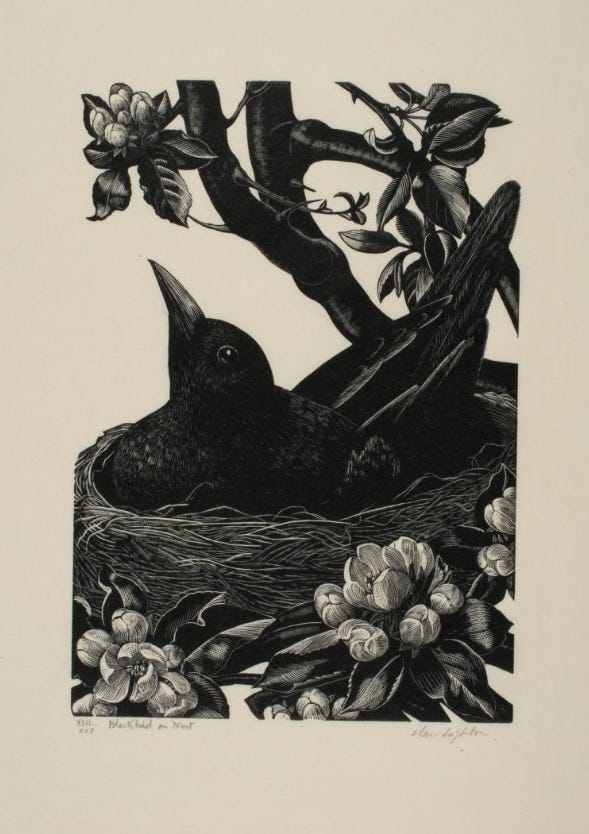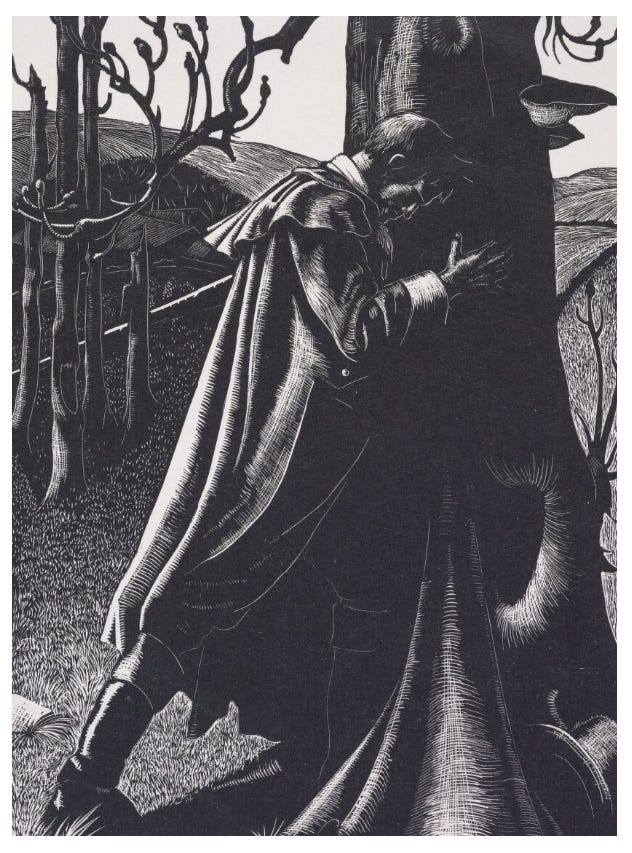'Heathcliff's Grief'
Springtime, Parasitic Love & Heart Rot
He was there—at least a few yards further in the park; leant against an old ash tree, his hat off, and his hair soaked with the dew that had gathered on the budded branches, and fell pattering round him. He had been standing a long time in that position, for I saw a pair of ousels passing and repassing scarcely three feet from him, busy in building their nest, and regarding his proximity no more than that of a piece of timber (Volume II: Chapter II).
Clare Leighton’s woodcut engravings are among my most favorite Wuthering Heights illustrations. The print, Heathcliff’s Grief, is dear to my heart because it depicts one of the most heartbreaking scenes in the novel—when Ellen finds Heathcliff among the trees.
The engraving appeals to me because I love fungi. I have made thousands of photos of fungi—and bracket fungi are some of the prettiest. I wanted to know more about the fungi Leighton depicts in her engraving, so I did a bit of research. And, I’m swooning!
Heathcliff told Ellen—when he left Catherine—he would be ‘amongst the larches.’ He is leaning against an old ash tree when she finds him. Common ash (Fraxinus excelsior) is the third most common tree in England.1
Ash is often parasitized in the U.S. by a fungus called, Perenniporia fraxinophila. The high-fruiting polypores are observed alone or in clusters. Dark (sometimes black) on their upper surface, and ivory to buff below, they certainly favor the fungi depicted by Leighton in “Heathcliff’s Grief.”
Clare Leighton was born in London, England and moved to America at the onset of the Second World War. She lived in New York, Maryland(Mid-Atlantic) and eventually moved to Connecticut (New England) and likely, was familiar with P. fraxinophila!
Perenniporia means, ‘perennial fruiting bodies,’ in other words, you can count on this fruiting organism to return to its host tree again-and-again. Fraxinophila means, ‘ash loving.’ So, this large, parasitic polypore fungus will return to its beloved ash tree until eventually, it loves it to death.
…it is preferable to be hated than loved by him.
Isabella on Heathcliff, Volume II: Chapter III
When I began reading about Perenniporia fraxinophila I exclaimed, “Clare had to know this!” After learning more, I discovered the fungus eventually causes heart rot, which leads to, “eventual failure by means of brittle fracture.”2
The budded branches of the ash tree illustrate to us it is springtime—days after Palm Sunday/Vernal Equinox, in fact. Heathcliff’s hat lies on the ground before him (just as it does in Brontë’s text). He dashed his head against the knotted trunk… wrote Brontë and we recognize, the pair of ousels have been frightened off by his violent, howling grief—mated blackbirds do not appear in Leighton’s engraving.3

Look Closely
Do you see how the knotted trunk at the base of the tree forms one-half of a heart? And, the two bracket fungi—one large, one tiny (maybe these represent Catherine the elder and Catherine the younger?). Is Isabella correct when she suggests Cathy would still be alive if not for Heathcliff’s perennial return?
Maybe I’m just a romantic mycophile…but I see so many symbolic nods to Nature in this beautiful engraving. What do you think? Did Clare Leighton intend to hint at a fracture in Catherine, an unavoidable heart rot caused by her love for Heathcliff? A foreshadowing of a fracture in Heathcliff, perhaps?
Here in Pennsylvania our ash trees are critically endangered because of the emerald ash borer beetle (Agrilus planipennis); unfortunately ash dieback is happening in the UK, too.
“Nasty Rotter,” Forbes-Laird Arborcultural Consultancy Tree Damage Alert (AAIS)
I believe Brontë is referring to the ring ouzel (Turdus torquotus); the Norton Critical Edition of Wuthering Heights simply refers to the birds as blackbirds, but they are smaller, slimmer and boast a white breast band. The engraving of a blackbird on a nest, by Clare Leighton, likely depicts the Eurasian blackbird (Turdus merula).




Poignant as always, thank you. Grief is captured nowhere as well as it is by Brontë in WH and is immersed and juxtaposed with the wonders of nature. I didn’t know about the engravings so grateful thanks for telling me about them and like you I share a love of funghi, enjoying painting and drawing growths that I find in the woodland near us.
I find it interesting that the spring buds are behind him and the shelf fungus, or heart rot, is ahead of him.